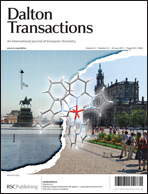A novel co-crystal, [(BTEMPO)22+·4I2·2I5−] (BTEMPO+ = 4-benzoyloxy-2,2,6,6-tetramethylpiperidinyl-1-oxoammonium cation), was successfully constructed using iodine and 4-benzoyloxy-2,2,6,6-tetramethylpiperidinyl-1-oxy free radical (BTEMPO) as starting materials and was well characterized by XRD, Raman and calculation. The co-crystal possesses a fascinating 3D anionic cage structure formed by V-shaped-pentaiodides and iodine via multiple halogen bonding and on a template of dimeric (BTEMPO)22+ cations. The cationic dimers are held together by a pair of reversed C–H⋯O![[double bond, length as m-dash]](https://www.rsc.org/images/entities/char_e001.gif) C hydrogen bonds and stabilized the 3D cage structure by C–H⋯I hydrogen bonds between methyl-protons of BTEMPO+ and iodine in the framework. The reaction mechanism of producing BTEMPO+ and I5− is proposed and verified by UV-Vis spectroscopy and ESI-MS, which initially goes through a halogen bonding complex between iodine and BTEMPO free radical and then Milliken inner charge transfer and charge separation reaction. UV-Vis absorption spectroscopy confirms the halogen bonding complex between I2 and BTEMPO with a formation constant of 6.94 M−1 and a 1 : 1 stoichiometry in chloroform. The ESI-MS directly led to observation of the less stable intermediates in the mechanism. It is believed that the mechanism proposed here is helpful in understanding the interactions between I2 and organic electron donors, which are debated frequently, and fills the gaps in the reaction mechanism of I2 with free radicals or analogues.
C hydrogen bonds and stabilized the 3D cage structure by C–H⋯I hydrogen bonds between methyl-protons of BTEMPO+ and iodine in the framework. The reaction mechanism of producing BTEMPO+ and I5− is proposed and verified by UV-Vis spectroscopy and ESI-MS, which initially goes through a halogen bonding complex between iodine and BTEMPO free radical and then Milliken inner charge transfer and charge separation reaction. UV-Vis absorption spectroscopy confirms the halogen bonding complex between I2 and BTEMPO with a formation constant of 6.94 M−1 and a 1 : 1 stoichiometry in chloroform. The ESI-MS directly led to observation of the less stable intermediates in the mechanism. It is believed that the mechanism proposed here is helpful in understanding the interactions between I2 and organic electron donors, which are debated frequently, and fills the gaps in the reaction mechanism of I2 with free radicals or analogues.

You have access to this article
 Please wait while we load your content...
Something went wrong. Try again?
Please wait while we load your content...
Something went wrong. Try again?
![[double bond, length as m-dash]](https://www.rsc.org/images/entities/char_e001.gif) C hydrogen bonds and stabilized the 3D cage structure by C–H⋯I hydrogen bonds between methyl-protons of BTEMPO+ and iodine in the framework. The reaction mechanism of producing BTEMPO+ and I5− is proposed and verified by
C hydrogen bonds and stabilized the 3D cage structure by C–H⋯I hydrogen bonds between methyl-protons of BTEMPO+ and iodine in the framework. The reaction mechanism of producing BTEMPO+ and I5− is proposed and verified by 

 Please wait while we load your content...
Please wait while we load your content...